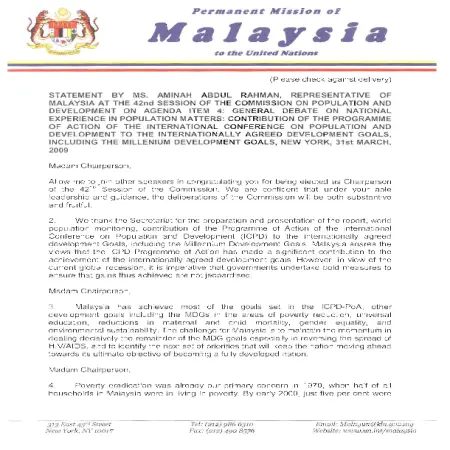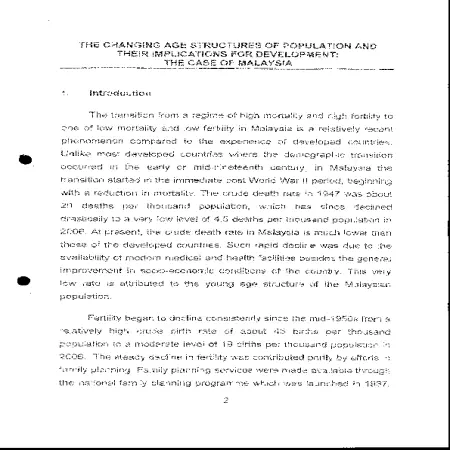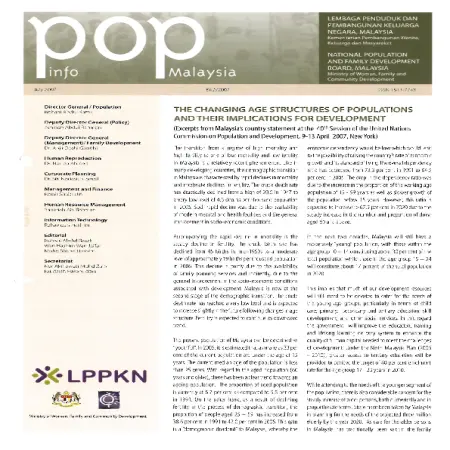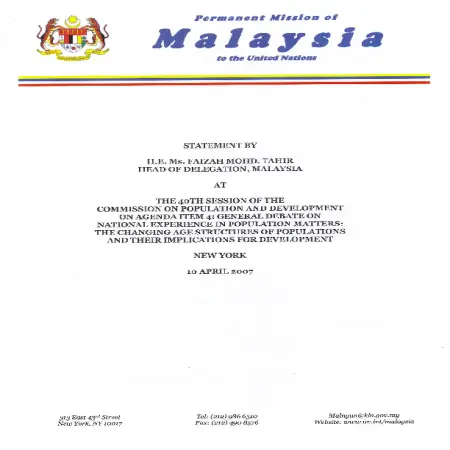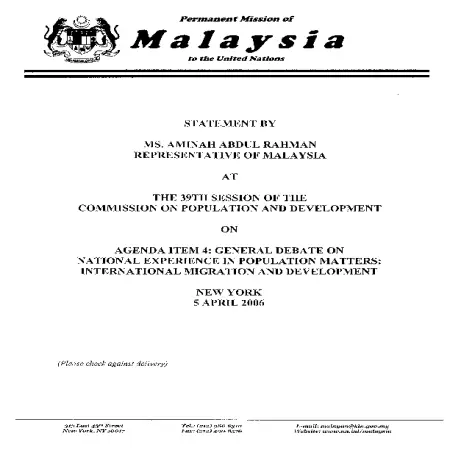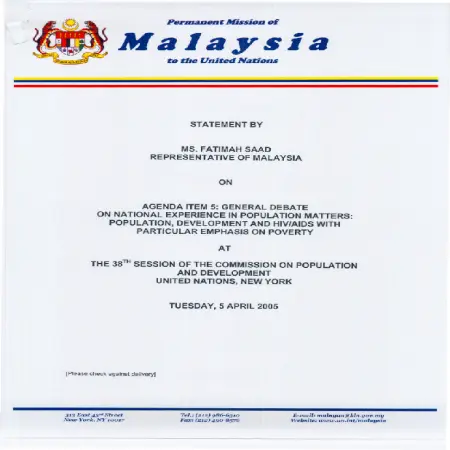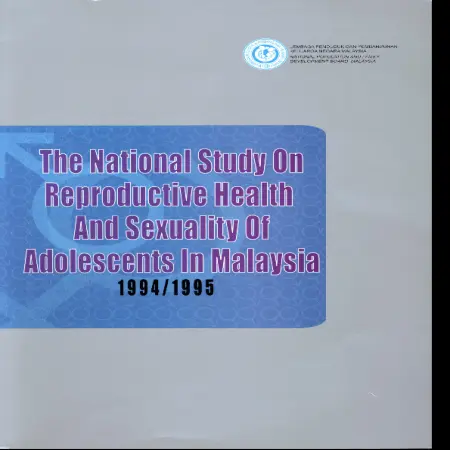Browse by Division/Agency
Results for Division/Agency : "LPPKN - National Population and Family Development Board, Malaysia: Population and Family Research Division"
|
|
The 4th East Asia Ministerial Forum on Families, "safe and resilient families: protecting and empowering at-risk and high risk families", Kuala Lumpur, 7-10 November 2010
Item Type: Country Statement
Editor:
Year: 00/11/2010
Abstract: A family is a living, evolving institution, affected by socio-economic factors as well as by the changes that shape the social environment in which it functions. More often, the changes and transformations have brought both gains and losses to family institutions. Hence, the challenge today is to reinforce positive changes and secure those in the new environment, and at the same time, to mitigate the negative consequences of changes, without dampening the momentum for positive evolution.
|
|
|
|
|
|
The 42nd session of the Commission on Population and Development on agenda item 4: general debate on national experience in population matters: contribution of the programme of action of the international conference on population and development to the internationally agreed development goals, including the millenium development goals, New York, 31st March, 2009
Item Type: Country Statement
Editor:
Year: 31/03/2009
Abstract: Malaysia has achieved most of the goals set in the ICPO-PoA, other
development goals including the MDGs in the areas of poverty reduction, universal education, reductions in maternal and child mortality, gender equality, and
environmental sustainability. The challenge for Malaysia is to maintain the momentum in
dealing decisively the remainder of the MOG goals especially in reversing the spread of
HIV/AIDS, and to identify the next set of priorities that will keep the nation moving ahead towards its ultimate objective of becoming a fully developed nation.
|
|
|
|
|
|
The 41st session of the Commission on Population and Development on item 4 : Population distribution, urbanisation, internal migration and development
Item Type: Country Statement
Editor:
Year: 08/04/2008
Abstract: Malaysia is currently experiencing an increase in population mobility mainly caused by industrialization and urbanization. Between 1970 and 2006, the proportion of population living in big cities (namely Kuala Lumpur, Penang and Johor Bahru) had doubled due to rapid urbanization mainly contributed by internal migration. Internal migration in Malaysia is gender, age and area selective, it is dominated by males mainly in the age group of 15 to 34 years, though female migration is expected to increase in the future.
|
|
|
|
|
|
The changing age structures of population and their implications for development: the case of Malaysia
Item Type: Conference or Workshop Item
Editor:
Year: 00/00/2008
Abstract: The transition from a regime of high mortality and high fertility to one of low mortality and low fertility in Malaysia is a relative recent phenomenon compared to the experience of developed countries. Unlike most developed countries where the demographic transition occurred in the early or mid-nineteenth century, in Malaysia the transition started in the immediate post World War II period, beginning with a reduction in mortality. The crude death rate in 1947 was about 20 deaths per thousand population, which has since declined drastically to a very low level of 4.5 deaths per thousand population in 2006. At present, the crude death rate in Malaysia is much lower than those of the developed countries. Such rapid decline was due to the availability of modern medical and health facilities besides the general improvement in socio-economic conditions of the country. This very low rate is attributed to the young age structure of the Malaysian population.
|
|
|
|
|
|
The changing age structures of populations and their implications for development
Item Type: Newsletter
Editor:
Year: 00/07/2007
Abstract: The demographic transition in Malaysia is characterized by rapid declines in mortality and moderate declines in fertility. Rapid decline in mortality was due to the availability of modern medical and health facilities and the general improvement in socio-economic condition. While, steady decline in fertility due to the availability of family planning services and indirectly, due to the general improvement in the socio-economic conditions associated with development.
|
|
|
|
|
|
The 40th session of the Commission on Population and Development on agenda item 4: general debate on national experience in population matters: the changing age structures of populations and their implications for development, New York, 10 April 2007
Item Type: Country Statement
Editor:
Year: 10/04/2007
Abstract: The transition from a regime of high mortality and high fertility to one of low mortality and low fertility in Malaysia is a relatively recent phenomenon. similar to the trends in many developing countries, the demographic transition in Malaysia is characterized by rapid declined in mortality and moderate declines in fertility. The crude death rate has drastically declines from a high of 20.0 in 1947 to a very low level of 4.5 deaths per thousand populations in 2006. Such a rapid declines was due to improvements in the health sectors and higher socio-economic development in the country.
|
|
|
|
|
|
The 39th session of the Commission on Population and Development on agenda item 4: general debate on national experience in population matters: international migration and development, New York, 5 April 2006
Item Type: Country Statement
Editor:
Year: 05/04/2006
Abstract: International migration, inter-alia, helps to ensure labour market flexibility and reduce labour market rigidity. At the same time, it must also be acknowledged that the impact of international migration, particularly low skilled foreign workers, on the receiving country's economy and society can be both positive and negative.
|
|
|
|
|
|
The 38th session of the Commission on Population and Development on agenda item 5: general debate on national experience in population matters: population, development and HIV/AIDS with particular emphasis on poverty, New York, 5 April 2005
Item Type: Country Statement
Editor:
Year: 05/04/2005
Abstract: The Government of Malaysia acknowledges the vast impact of the HIV epidemic on the demographic profile of the country. It affects population growth, distribution and structure. It impacts upon widowhood with the concomitant increase in orphans among children and in the reduction of the reproductive years resulting in lower fertility.
|
|
|
|
|
|
The National Study on reproductive health and sexuality of adolescents in Malaysia 1994/1995
Item Type: Research Report
Editor:
Year: 00/00/1996
Abstract: The National Study on Reproductive Health and Sexuality of Adolescents in Malaysia was initiated with the aim of formulating a National Programme on Reproductive Health for Adolescents. The specific objectives of the study are:
i. to establish the status of the knowledge, attitude
and practice of adolescents with regard to sexual
and reproductive health,
ii. to identify the constraints that adolescents face in
seeking information and service relating to sexual
and reproductive health,
iii. to obtain the participation of adolescents in the
design and implementation of programmes and
activities for their own welfare.
The single most expected outcome of the Study on Reproductive Health and Sexuality of Adolescents in Malaysia is a Cabinet memorandum which will propose appropriate policy and programme changes for the promotion and maintenance of optimal reproductive health among Malaysian adolescents geared towards the year 2020. This Memorandum will serve as a vital national reference and benchmark for evaluating future trends and patterns. It will be the basis for the reorientation of values, attitudes and approaches for the management of sexuality and reproductive health of adolescents in the country.
|
|
|
|
|
|
The report on West Malaysian Family Survey 1966-1967
Item Type: Research Report
Editor:
Year: 00/01/1968
Abstract: The data presented in this report was collected under the Statistics Act, No 34, 1965 by the Department of Statistics. This report is the First Malaysia-Wide Family survey was conducted at the end of 1966 and the beginning of 1967 with the objective of the finding Knowledge, Attitude and Practice of the people in Family Planning.
|
|
|
|






